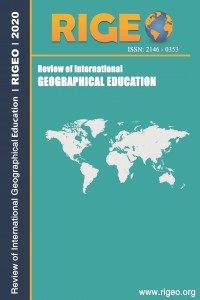Evaluating Progression in Students’ Relational Thinking While Working on Tasks with Geospatial Technologies
Evaluating Progression in Students’ Relational Thinking While Working on Tasks with Geospatial Technologies
One of the facets of geographic literacy is the ability to think in a structured way about geographic
relationships. Geospatial technologies offer many opportunities to stimulate students’ geographic
relational thinking. The question is: How can these opportunities be effectuated? This paper discusses
the results of a process-oriented experiment that aimed to gain insight into the characteristics of
students’ learning processes and the factors that influence students’ learning when they work with
geospatial technologies, and to provide ideas on how to optimise the learning outcomes. Eighteen
students were observed in a laboratory research setting while working on tasks with a geogame and a
WebGIS, and were interviewed about their learning afterwards. The study shows that using appropriate
educational technologies is only part of the story. Well-designed tasks and active coaching by the
teacher also seem to be indispensable ingredients. The data suggest that, in order to increase the
effectiveness of instruction methods with geospatial technologies, teachers should include tasks in
which students have to summarize their system knowledge in a conceptual framework, and that
teachers should help students structure their system knowledge via dialogical teaching. In the tasks and
support, attention should be paid to the grammar of relational thinking.
___
- Anderson, L., & Krathwohl, D. (2001). A taxonomy for learning, teaching, and assessing: A revision of Bloom's Taxonomy of Educational Objectives. New York, NY: Longman.
- Baker, R., & White, S. (2003). The effects of GIS on students’ attitudes, self-efficacy and achievement in middle school science classrooms. Journal of Geography, 102, 243-254.
- Bednarz, S., & Van der Schee, J. (2006). Europe and the United States: The implementation of Geographical Information Systems in secondary education in two contexts. Technology, Pedagogy and Education, 15, 191-205.
- Chen, Z., & Klahr, D. (1999). All other things being equal: acquisition and transfer of the control of variables strategy. Child Development, 70 (5), 1098–1120.
- Coffield, F., Mosely, D., Hall, E., & Ecclestone, K. (2004). Learning styles and pedagogy in post-16 learning: a systematic and critical review. London, UK: LSRC.
- Coffin, C. (2004). Learning to write history: The role of causality. Written Communication, 21, 261-289.
- Cohen, J. (1988). Statistical power analysis for the behavioral sciences (2nd ed.). Hillsdale, NJ: Lawrence Earlbaum Associates.
- Favier, T. (2011). Geographic Information Systems in secondary geography education: Theory and practice. Enschede: Ipskamp Press.
- Favier, T., & Van der Schee, J. (2014). The effects of geography lessons with geospatial technologies on the development of high school students’ relational thinking. Computers & Education, 76, 225–236.
- Hajer, M., & Meestringa, T. (2009). Handboek taalgericht vakonderwijs. Bussum, The Netherlands: Coutinho.
- Hall-Wallace, M., & McAuliffe, C. (2002). Design, implementation, and evaluation of GISbased learning materials in an introductory geoscience course. Journal of Geoscience Education, 15, 1-14.
- Het Hooghuis (2014). Leerstijlentest van Vermunt. Last retrieved June 2014, http://edu.hethooghuis.nl/vz/leren-en-coachen/testvermunt.htm
- Hwang, G.-J., Yang, L.-H., & Wang, S.-Y. (2013). A concept map-embedded educational computer game for improving students’ learning performance in natural science courses. Computers and Education, 69, 121-130.
- Jackson, P. (2006). Thinking geographically. Geography (91), 199-204.
- Kerski, J. (2003). The implementation and effectiveness of Geographic Information Systems technology and methods in secondary education. Journal of Geography, 102, 128-137.
- Lam, C., Lai, E., & Wong, J. (2009). Implementation of geographic information systems (GIS) in the secondary geography curriculum in Hong Kong: Current situations and future directions. International Research in Geographicand Environmental Education, 18, 57-74.
- Lindsay, E. K. (1999). An analysis of matches of teaching styles learning styles and the uses of educational technology. Doctoral dissertation, Raleigh NC: North Carolina State University.
- Manochehc, N.-N. (2006), The influence of learning styles on learners in e-learning environments: An empirical study. Computers in Higher Education Economics Review 18 (1), 10-14.
- Milson, A., & Kerski, J. (2012). Around the world with GST. Social Education, 76 (2), 105– 108.
- Palladino, A., & Goodchild, M. (1993). A place for GIS in the secondary schools? Geo Info Systems, 3 (4), 45-49.
- SchoolVO (2014). www.schoolvo.nl. Last retrieved November 2014,
- Sinton, D., & Lund, J. (2007). Understanding place. Redlands, CA: ESRI press.
- Taylor, L. (2006). Think piece: Concepts in geography. Last retrieved august 2014, www.geography.org.uk
- Van de Pol, J., Volman, M., & Beishuizen, J. (2010). Scaffolding in teacher-student interaction: A decade of research. Educational Pscyhology Review, 22 (3), 271-297.
- Van der Schee, J. (2000). Helping children to analyse a changing world: Looking for patterns and relationships in space. In M. Robertson, & R. Gerber, The child's world: Triggers for learning (pp. 214-231). Melbourne, Australia: Australian Council for Educational Research.
- Van Drie, J., & Van Boxtel, C. (2003). Developing conceptual understanding through talk and mapping. Teaching History, 110, 27-31.
- Vermunt, J. (1994). Inventory of learning styles in higher education. Leiden: Leiden University.
- West, B. (2003). Student attitudes and the impact of GIS on thinking skills and motivation. Journal of Geography, 102, 267-274.
- Wilschut, A. (2013). De taal van burgerschap. Amsterdam, the Netherlands: Amsterdam University Press.
- Woodcock, J. (2005). Does the linguistic release the conceptual? Helping year 10 to improve their causal reasoning. Teaching History, 119, 5-14.
- ISSN: 2146-0353
- Başlangıç: 2011
- Yayıncı: Eyüp ARTVİNLİ
Sayıdaki Diğer Makaleler
Geography in Secondary Schools: Researching Pupils’ Classroom Experiences
Tim FAVIER, Joop VAN DER SCHEE
Global Citizenship Education in a Secondary Geography Course: The Students’ Perspectives
Aikaterini KLONARI, Achilleas MANDRIKAS
